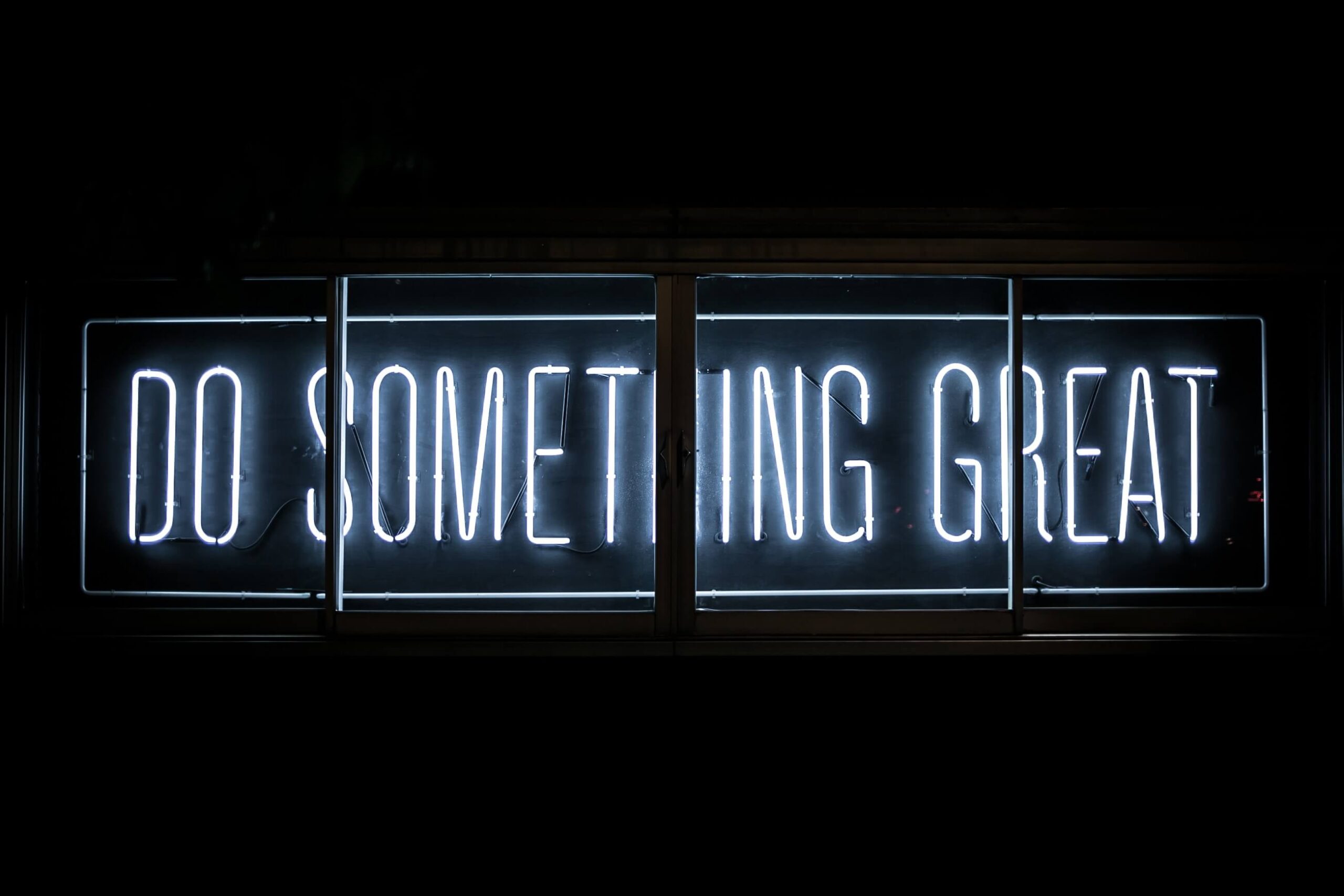
Should your brand publish a manifesto? Are you that kind of brand? Do you have what it takes, and are you ready?
To help you decide, we’ve published a list of prerequisites to creating a brand manifesto.
Creating a brand manifesto is like launching a major publicity or ad campaign. If you’re ready, it can change the future of your brand. But you do need to have the foundations in place.
1. You Know Your Positioning
Who is your brand for, specifically? What makes you unique in the market? When people think of your brand, what comes to mind?
The line between positioning and brand messaging gets blurred — and the two are tightly linked. But positioning is strategy, not copywriting.
Specifically, positioning is about how you aim to deliberately own a defined space in your customer’s mind. It’s about where they locate you when they think of the market in which you play.
There are as many different ways to “do” positioning as there are positions to take. Personally, I’ve learned from Blair Enns’ Positioning Bootcamp, CXL’s positioning course by Brendan Dell, and the wildly successful founder of a CPG startup, Suzie Yorke.
Don’t worry about whether you’ve defined your positioning via one or the other textbook methods. Just be sure that you can answer the questions above because we’ll need those answers to create a brand manifesto.
Not sure you’re well-positioned? Reach out to book a consulting session.
2. You’ve Defined Your Brand Messaging
You may have copy… But do you have a brand message?
The two are not quite the same.
Brand messaging is about what your brand says and why. How you say it in copywriting comes next.
I would recommend that you define your brand message before writing a manifesto, and here’s why:
Your manifesto is sometimes called a “statement piece” or a “hero piece” for your brand. It’s an attention-grabbing, pivotal piece of brand messaging that expresses the “Big Idea” behind your brand.
To get the most momentum from your brand manifesto, it should reinforce the rest of your message.
So the question is, do you really have a brand message?
Few brands have fully defined messaging that’s ready to be lifted out of a brand book to shape what goes on the page.
Most brands are partway through the process.
For example, if you’ve been through a positioning exercise, you may have the bones of a brand messaging strategy. Some positioning processes include the work of defining your story, your emotional and functional benefits, the outcomes you deliver, your brand promise, your proofs, and more.
If you’ve done this work and the message is powerful, you may be ready for a manifesto.
More often, you have some of these pieces but there are gaps in your messaging strategy. You may have a tagline, for example, and know what your brand message is, but you’ve never explicitly and comprehensively defined it.
In other cases, your brand message is out of date with your current positioning. Your market has changed, as have your offers and your audience. It’s time to rethink what you say and why.
Brand messaging is always a work in progress. You should revisit your message regularly, but especially before investing in a major campaign and piece of advertising like a manifesto.
If your brand message needs work, don’t despair. We can do it together as part of the process leading up to creating your brand manifesto. Reach out to find out how.
3. You Have A Vision
As discussed in my interview with Todd Jones, to write a brand manifesto you should have a vision for the people you serve — one that connects what you offer with their deepest desires and ideal future.
This “promised land” can be part of your brand messaging, but it’s so important to the brand manifesto that the vision deserves its own section here.
A vision should be big, bold, and inspiring, but also tethered to what your brand offers. There should be a logical link between the two.
Your brand doesn’t need to be solely responsible for bringing about this idealized future. You just need to play a role.
Be sure to give the dream dimensions. This is what separates a standard vision statement from a vision that inspires and rallies your people.
What does the desired future state look like and feel like for your people? How will their lives change in specific ways?
Don’t guess. Make sure it’s rooted in research. You should survey, interview, and ethically spy on your audience to understand their unrealized dreams.
A powerful vision is inspiring. It should motivate leaders and employees and give meaning to their work. When your customers, clients, or stakeholders hear you describe the vision for their future, their response should be, “Yes, that’s exactly it. That’s what I want.”
4. You Know What’s Broken
Your vision is an ideal future because it’s not yet within reach. The world is still broken and there are forces that keep your people back from the promised land.
Whether you call those forces your brand enemy, monster, or villain, something is holding the people you serve back from reaching the promised land.
Not sure where to look?
Think about processes. What is broken in the way things are done in your industry?
Think about power systems and structures. How are things set up to keep your people back?
Think about traditions and unconscious habits. What are people doing, ‘just because’ and how does that need to change to reach the promised land?
Think about mindsets or beliefs. What myths or unhelpful ways of thinking are barriers to a better future?
Think about the alternatives to your brand. What makeshift or imperfect solutions is your brand replacing?
You may have defined this villain as part of your brand messaging process. Do a gut check now to make sure you’ve named the right villain because the enemy of your audience will play an important role in your brand manifesto.
Notice the enemy isn’t a person or a people group. There are, no doubt, some parties, and movements that are organized around blaming people, but obviously, we don’t do that because it’s unethical and illogical.
The villain isn’t likely an individual competitor, either, though it might be a category that your brand replaces.
The villain also isn’t simply a problem your audience faces. It’s more like the root cause of their problem. For example, I know a founder of a low-sugar snack bar. In defining her brand message, she chose sugar as her enemy, not extra pounds, low energy, foggy brain.
When you work deeply in a market, you often just know what’s broken. You earn that perspective through your deep work, which incidentally, is why good positioning is foundational. When you’re well-positioned, you solve more specific problems for more specific markets. In so doing, you become an expert on those problems.
Sometimes you’ll import your perspective from a different market. That fresh lens is what gives you a unique point of view from which to diagnose what’s broken.
The right villain might be one your audience has mentioned in surveys, interviews, or online. It should certainly be rooted in their experience, though quite likely it’s a barrier they haven’t yet consciously recognized.
When naming a villain, you want to hit a sweet spot of surprise and recognition. You want that “ah ha” moment.
The villain should be something your audience will immediately recognize once you name it, as if it were just on the edge of their consciousness. A villain that takes too much explaining isn’t a good one. Likewise, steer clear of a brand villain that’s too obvious.
As with the vision, add dimension to your perspective of what’s broken. Think about the implications of the problem for your audience. What will it mean for them if the enemy isn’t defeated? How will the ogre evolve over time?
5. You’re Ready To Take A Stand
A brand manifesto is, by definition, challenging — polarizing even.
In The Atlantic, Julian Hanna says that manifestos are theatrical, that they embrace paradox, that they’re “fiction dressed as fact”, “always on the bleeding edge”, and infused with the magic of promise, belief, and hope.
A brand manifesto is an expression of “radical differentiation” (see Louis Grenier’s course for CXL). To be radically different, you must commit to a big idea and be intensely human in public.
This stance isn’t exclusive to Avant Garde art brands and radical social movements. In fact, I’ve written a brand manifesto for an exceedingly professional B2B firm that serves some of the world’s most renowned technology firms.
You must simply be prepared to strongly attract the right people, and repel the wrong people. Depending on how polarizing a stand you choose to take, the wrong people may even criticize your brand.
If you’ve always been a brand with opinions or a controversial brand, this may feel natural. If you’ve traditionally been middle-of-the-road in your messaging, it’s a mindset shift.
Your leadership must be willing to take risks on opinions and predictions that may prove to be wrong. To keep the edges on the message. To be “for” some people, and not for others.
You may think this sounds too risky. The fact is that not standing out is risky. It’s too hard to cut through the market clutter with a brand that sounds like every other brand. What’s more, people are voting with their wallets for the brands that publicly declare their values.
Your audience expects you to take a stand. How far you turn the dial is up to you.
6. Your Perspective Is Other-Centered
Your brand manifesto is only a rallying cry if it’s about others.
This truth is one of the paradoxes of a brand manifesto. Your manifesto is an expression of your brand’s truth, but it should never feel like it’s about your brand. To your audience, it should feel like it speaks to their experience and unspoken dreams.
It’s easy to center your own story, yourself, and your brand. It takes effort to keep the focus on the other. That effort usually comes down to a) focus, and b) research.
You first need to be focused on a specific audience (this comes back to positioning). Your audience should be narrow enough to share psychographic characteristics. They should have in common certain experiences, beliefs, problems, access to solutions. It should be wide enough to be a viable market.
Once you’re focused, you can meaningfully research that audience so that you know their lived experience. That insight will bring your brand manifesto to life. You want it to feel to your audience like you’re reading a script written in their very soul.
Chances are, you’ve heard of the Hero’s Journey or at least of Story Brand. It’s a narrative framework following a traditional arc:
The hero (your audience) has a vision but is barred from the promised land by a villain
They meet a guide (your brand) who calls them to action and equips them (with your product, service, etc.) to overcome the villain
Thanks to the help of the guide, your hero defeats the villain and reaches the promised land
If you’re ready for your audience to be the hero and your brand to be the “guide on the side”, you have the right mindset to be a manifesto brand.
7. You Can Be Congruent
Iconic brands have their own internal logic — and when you see that alignment, it’s a thing of beauty.
Louis Grenier, who teaches Radical Differentiation for CXL, talks about “congruency.” The elements of your brand message, products, services, and programs must all align, like pieces of a puzzle that create a greater whole.
Congruency is beautiful, but it’s also necessary. People expect continuity, coherence, and consistency in your brand. Without it, they feel confused or disappointed. They may see your message as insincere, and you lose brand equity.
Congruency is important for any brand, but especially for a brand that creates a manifesto.
Your brand manifesto will be infused with values and opinions. You’ll make a public and memorable statement about where you stand. Make sure your company is ready to stay in alignment with your public declaration and even use it as a moral compass.
Put simply, if you say it, make it true.
Quick Brand Manifesto Readiness Checklist
Use this checklist to gauge your readiness and find out where to start.
- Is your leadership team clear on who your brand serves, specifically?
- Have you defined the psychographics of your ideal customer, client, or donor? (I.e. the psychological characteristics and traits such as values, desires, goals, interests, and lifestyle choices.)
- Do you know how you’ll position your brand as unique and different for that audience? (Vis-à-vis the competition, but also the alternatives to your category.)
- Do you know your customer’s journey, from first realizing they have a problem to reaching their goal with help from your brand?
- Are you excited for your audience to be the hero of your brand story while your brand plays a supporting or guiding role?
- Have you defined the most important outcomes, emotional and functional benefits your brand delivers to that target audience?
- Have you defined the most important features that let you deliver those outcomes and benefits?
- Have you gathered proof or evidence that your brand does what you say it does? (I.e. social proof, credentials, quantitative evidence, studies, third-party expert endorsements, and so on.)
- Does your brand messaging include a Big Idea? (This one is a bit tricky, but a big idea is essentially a core concept that’s unique, potentially surprising, and points to an unfulfilled and often emotional desire of your audience.)
- Do you have a vision for how your brand can fulfill your audience’s vision of a better future? Is it rooted in audience research? Do you know specifically how their lives will change when this vision is realized?
- Have you defined your audience’s “enemy,” or what’s holding them back from this better future? (I.e. Broken processes, systems, structures, mindsets, beliefs, traditions, routines, or alternatives to your brand that aren’t serving your audience.)
- Is your leadership team ready to take risks on messaging? To be a little bit bolder, edgier, and more emotional than your competitors?
- Are you ready to be “for” some audiences and clearly not for others? (Tip: You can do so while still being kind.)
- Are you ready to stand by ideas that you think are right… but that might turn out to be wrong?
- Is your company consistent with the values you currently profess, or is it a work in progress?
- When you make strong statements about what you’re for and against as a brand, are you prepared to be consistent with those statements? What if it means changing aspects of your supply chain, your processes, your policies, etc?
How Ready Are You For A Brand Manifesto?
Could you say yes or maybe to most of these? Just a few?
You don’t need to have all of these in place to work with Conversion Copy Co.
We can help you lay the foundation with powerful positioning, brand messaging, a vision, villain and perspective rooted in deep audience insight.
Book a call to discuss the steps your team needs to take to be ready for a brand manifesto.





























